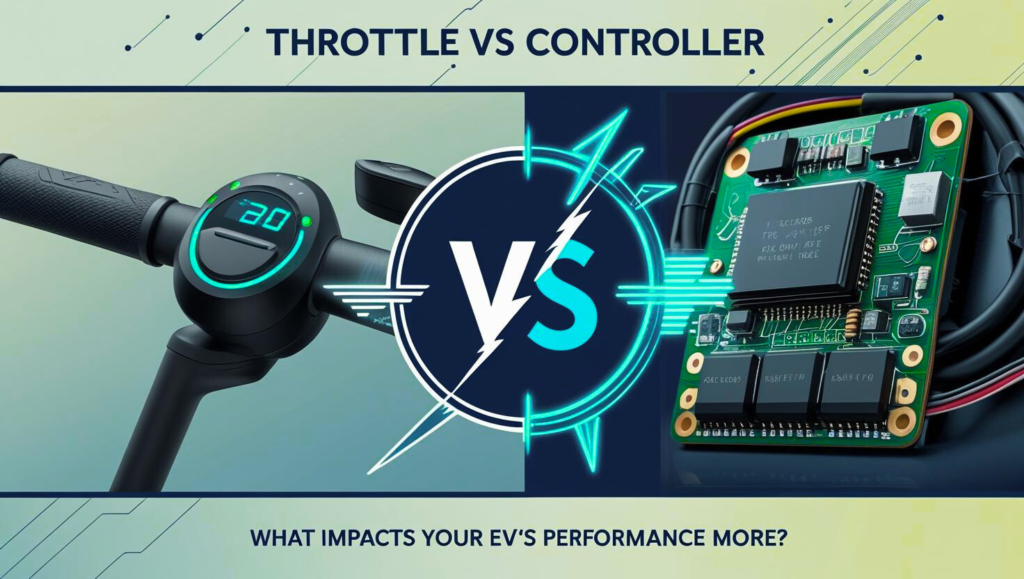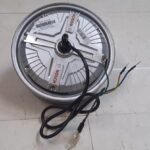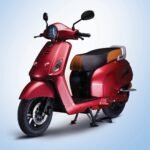
If you’ve ever felt your electric scooter wasn’t as responsive or powerful as expected, your first thought might be to replace the motor or battery. But often, it’s the controller and throttle that play a much larger role in shaping how your EV behaves.
In this blog, we’ll break down what these two components do, how they interact, and which one impacts your electric scooter’s performance more. Whether you’re troubleshooting laggy acceleration or planning an upgrade, understanding the throttle vs controller debate is essential.
What Is a Throttle in an EV?
The throttle is the device you twist or press (depending on the model) to accelerate your scooter or bike. It sends a voltage signal to the controller indicating how much power should be sent to the motor.
Types of Throttles
- Twist Throttle: Like a motorcycle grip. Common in scooters and bikes.
- Thumb Throttle: A small lever you press with your thumb.
- Finger Trigger Throttle: Usually used in performance e-bikes.
What Is a Controller in an EV?
The controller is the EV’s command center. It regulates how much current flows from the battery to the motor based on the input received from the throttle. It also manages brake sensors, regenerative braking, display units, and other accessories.
How Do They Work Together?
- You press or twist the throttle.
- The throttle sends a voltage signal (usually between 1V–4.2V) to the controller.
- The controller interprets this and supplies proportional current to the motor.
- Motor reacts accordingly — speeding up, slowing down, or maintaining pace.
If either component is poorly matched or malfunctioning, you’ll feel:
- Lag in response
- Jerky acceleration
- No throttle control
- Sudden cutoffs
Key Performance Metrics Affected
| Metric | Controlled by Throttle | Controlled by Controller |
| Acceleration Response | ✅ Yes | ✅ Yes |
| Top Speed | ❌ No | ✅ Yes |
| Torque Delivery | ❌ No | ✅ Yes |
| Throttle Smoothness | ✅ Yes | ✅ Yes |
| Energy Efficiency | ❌ No | ✅ Yes |
| Safety Features (cutoff) | ❌ No | ✅ Yes |
Common Throttle Problems (And Fixes)
1. Laggy Response
- May be caused by dirt in the throttle mechanism
- Test with multimeter to confirm voltage signal
2. Stuck Acceleration
- Faulty spring return or shorted wires
- Replace throttle if it doesn’t return to 0V at idle
3. No Power Despite Full Throttle
- Check throttle connector to controller
- Test controller’s voltage input port
Common Controller Problems (And Fixes)
1. Overheating on Hills
- Controller amperage too low for load
- Upgrade to 1000W+ controller
2. Motor Vibrates or Stalls
- Incorrect phase wire connection
- Rewire according to controller manual
3. Limited Top Speed
- Check if controller is speed-capped (some are locked at 25 km/h)
When Should You Upgrade the Throttle?
Upgrade your throttle if:
- It’s physically damaged
- You want smoother or finer acceleration control
- You’re upgrading the controller and pin types don’t match
- You’re switching from a twist grip to a thumb or finger style
Example: Switching to a waterproof 3-pin digital throttle for a rain-prone area.
When Should You Upgrade the Controller?
Upgrade your controller if:
- Your motor wattage has increased
- Your battery voltage is higher than the old controller’s rating
- You want better hill climbing or torque
- You’re switching from a lead-acid to lithium battery system
Budget-Friendly Upgrades That Improve Performance
| Component | Product Example | Buy Now |
| Throttle | 3-Pin Digital Thumb Throttle | Throttle Shop |
| Controller | 60V 1000W BLDC Sine Wave Controller | Controller Shop |
| Battery | 60V 24Ah Lithium Battery | Battery Shop |
Real-World Example: What Gave Better Results?
Case A: Rider upgraded only throttle
- Acceleration was slightly smoother
- No improvement in top speed or torque
Case B: Rider upgraded controller from 48V 350W to 60V 1000W
- Drastic change in pickup, top speed, hill climbing
- Required battery upgrade
Conclusion:
Throttle improves control feel, but controller directly improves raw performance.
Related Blogs for More Insights
- Affordable EV Controllers for Daily Use
- Choosing the Right Motor Kit for Your Electric Scooter
- How to Identify a Failing EV Battery
- The Complete Guide to Choosing the Right EV Charger
CTA – Ready to Boost Your Scooter’s Power?
Whether you’re upgrading your throttle for better control or your controller for a serious power boost, choose verified and affordable options at:
FAQs – Throttle vs Controller
Q. Which impacts speed more: throttle or controller?
The controller. Throttle only sends a signal; the controller determines current output.
Q. Do I need to change both together?
Not always. But if connectors or voltage specs differ, you may need to match both.
Q. Are all throttles compatible with any controller?
No. Always match pin configuration (2-pin, 3-pin, waterproof, etc.)
Q. Will a new controller improve battery life?
Possibly. A smart controller can optimize current flow, improving efficiency.






Creating Ghibli-style art is a dream for many, and with tools like 지브리 AI, that magic is now just a click away. It’s amazing how AI brings Miyazaki’s charm to life for free!